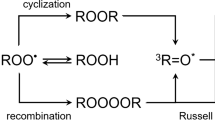Summary
Ascorbic acid (vitamin C) is a primary antioxidant for cells. But, ascorbic acid added to culture medium is not readily available to cells in culture, because it is unstable in aqueous media. We determined the conditions required to obtain and maintain a constant concentration of ascorbate in the culture medium using ascorbate and ascorbate-phosphate. The study was carried out with human fibroblasts and the amounts of ascorbate in the culture medium were determined by high performance liquid chromatography. A mixture of 0.25 mmol/L ascorbate and 0.45 mmol/L ascorbate-phosphate provided a constant concentration of ascorbate in the culture medium. This constant ascorbate concentration proved to be nontoxic for cells and stimulated cell growth in the short term and long term.
Similar content being viewed by others
References
Austria, R.; Semenzato, A.; Bettero, A. Stability of vitamin C derivatives in solution and topical formulations. J. Pharm. Biomed. Anal. 15:795–801; 1997.
Brigelius-Flohe, R.; Flohe, L. Ascorbic acid, cell proliferation, and cell differentiation in culture. Subcell. Biochem. 25:83–107; 1996.
Buettner, G. R. Ascorbate autoxidation in the presence of iron and copper chelates, Free Radic. Res. Commun. 1:349–353; 1986.
Buettner, G. R. In the absence, of catalytic metals ascorbate does not autoxidize at pH 7: ascorbate as a test for catalytic metals. J. Biochem. Biophys. Methods 16:27–40; 1988.
Buettner, G. R. The pecking order of free radicals and antioxidants: lipid peroxidation, alpha-tocopherol, and ascorbate. Arch. Biochem. Biophys. 300:535–543; 1993.
Buettner, G. R.; Jurkiewicz, B. A. Catalytic metals, ascorbate and free radicals: combinations to avoid. Radiat. Res. 145:532–541; 1996.
Diliberto, E. J., Jr.; Daniels, A. J.; Viveros, O. H. Multicompartmental secretio of ascorbate and its dual role of dopamine beta-hydroxylation. Am. J. Clin. Nutr. 54(Suppl. 6):1163S-1172S; 1991.
Ernster, L.; Forsmark-Andree, P. Ubiquinol: an endogenous antioxidant in aerobic organisms. Clin. Investig. 71:60–65; 1993.
Geesin, J. C.; Gordon, J. S.; Berg, R. A. Regulation of collagen synthesis in human dermal fibroblasts by the sodium and magnesium salts of ascorbyl-2-phosphate. Skin Pharmacol. 6:65–71; 1993.
Hata, R.; Senoo, H. l-Ascorbic acid 2-phosphate stimulates collagen accumulation, cell proliferation, and formation, of a three-dimensional tissue like substance by skin fibroblasts. J. Cell. Physiol. 138:8–16; 1989.
Hata, R.; Sunada, H.; Arai, K.; Sato, T.; Ninomiya, Y.; Nagai, Y.; Senoo, H. Regulation of collagen metabolism and cell growth by epidermal growth factor and ascorbate in cultured human skin fibroblasts. Eur. J. Biochem. 173:261–267; 1988.
Herbert, V.; Shaw, S.; Jayatilleke, E. Vitamin C-driven free radical generation from iron. J. Nutr. 126:1213–1220; 1996.
Ishikawa, O.; Kondo, A.; Okada, K.; Miyachi, Y.; Furumura, M. Morphological and biochemical analyses on fibroblasts and self-produced collagens in a novel three-dimensional culture. Br. J. Dermatol. 136:6–11; 1997.
Ivanov, V. O.; Ivanova, S. V.; Niedzwiecki, A. Ascorbate affects proliferation of guinea pig vascular smooth muscle cells by direct and extracellular matrix-mediated effects. J. Mol. Cell. Cardiol. 29:3293–3303; 1997.
Kitts, D. D. An evaluation of the multiple effects of the antioxidant vitamins. Trends Food Sci. Technol. 8:198–203; 1997.
Kurata, S.; Senoo, H.; Hata, R. Transcriptional activation of type I collage genes by ascorbic acid 2-phosphate in human skin fibroblasts and its failure in cells from a patient with alpha 2 (I)-chain-defective Ehlers-Danlos syndrome. Exp. Cell Res. 206;63–71; 1993.
Legrand, C.; Bour, J. M.; Jacob, C., et al. Lactate dehydrogenase (LDH) activity of the number of dead cells in the medium of cultured eukaryotic cells as marker. J. Biotechnol. 25:231–243; 1992.
Liebler, D. C. The role of metabolism in the antioxidant function of vitamin E. Crit. Rev. Toxicol. 23:147–169; 1993.
Michiels, C.; Toussaint, O.; Remacle, J. Comparative study of oxygen toxicity in human fibroblasts and endothelial cells. J. Cell. Physiol. 144:295–302; 1990.
Navas, P.; Villalba, J. M.; Cordoba, F. Ascorbate function at the plasma membrane. Biochim. Biophys. Acta 1197:1–13; 1994.
Ono, M.; Aratani, Y.; Kitagawa, I.; Kitagawa, Y. Ascorbic acid phosphate stimulates type IV collagen synthesis and accelerates, adipose conversion of 3T3-L1 cells. Exp. Cell Res. 187:309–314; 1990.
Padh, H. Cellular functions of ascorbic acid. Biochem. Cell. Biol. 68:1166–1173; 1990.
Petrrkofsky, B. The effect of ascorbic acid on collagen polypeptide synthesis and proline hydroxylation during the growth of cultured fibroblasts. Arch. Biochem. Biophys. 152:318–328; 1972.
Phillips, C. L.; Combs, S. B.; Pinnell, S. R. Effects of ascorbic acid on proliferation and collagen synthesis in relation to the donor age of human dermal fibroblasts. J. Investig. Dermatol. 103:228–232; 1994.
Phillips, C. I.; Tajima, S.; Pinnell, J. R. Ascorbic acid and transforming growth factor beta 1 increase collagen biosynthesis via different mechanisms: coordinate regulation of pro-alpha 1 (I) and pro-alpha 1 (III) collagens. Arch. Biochem. Biophys. 295:397–403; 1992.
Sakagami, H.; Satoh, K.; Ohata, H., et al. Relationship between ascorbyl radical intensity and apoptosis-inducing activity. Anticancer Res. 16:2635–2644; 1996.
Speek, A. J.; Schrijver, R.; Schreurs, W. H. Fluorimetric determination of total vitamin C in whole blood by high-performance liquid chromatography with pre-column derivatization. J. Chromatogr. 305:53–60; 1984.
Washko, P. W.; Wang, Y.; Levine, M. Ascorbic acid recycling in human neutrophils. J. Biol. Chem. 268:15,531–15,535; 1993.
Yamamoto, I.; Muto, N.; Murakami, K.; Akiyama, J. Collagen synthesis in human skin fibroblasts is stimulated by a stable form of ascorbate, 2-o-alpha-d-gluco-pyranosyl-l-ascorbic acid. J. Nutr. 122:871–877; 1992.
Author information
Authors and Affiliations
Corresponding author
Rights and permissions
About this article
Cite this article
Chepda, T., Cadau, M., Girin, P. et al. Monitoring of ascorbate at a constant rate in cell culture: Effect on cell growth. In Vitro Cell.Dev.Biol.-Animal 37, 26–30 (2001). https://doi.org/10.1290/1071-2690(2001)037<0026:MOAAAC>2.0.CO;2
Received:
Accepted:
Issue Date:
DOI: https://doi.org/10.1290/1071-2690(2001)037<0026:MOAAAC>2.0.CO;2




